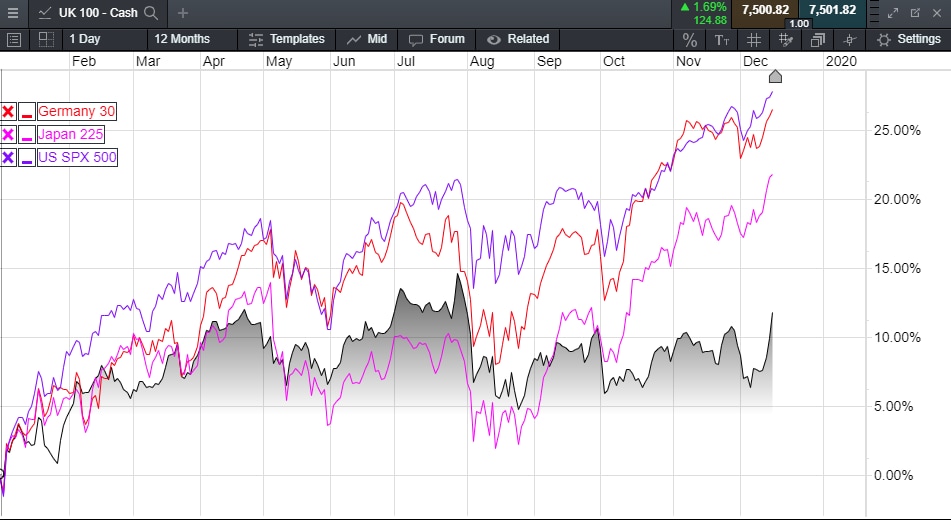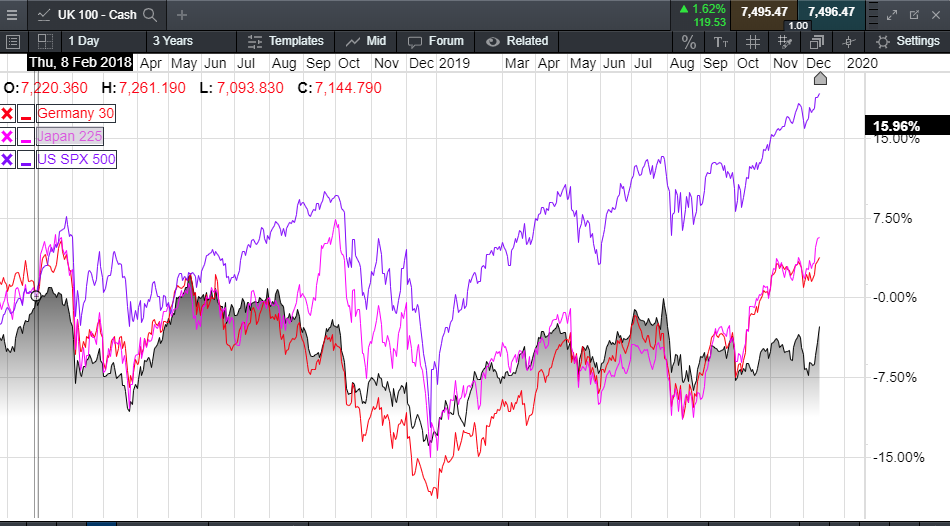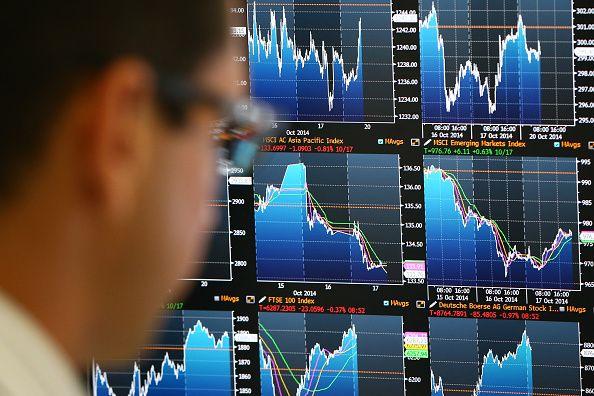In terms of stock market performance this year we’ve seen some decent gains across the board, despite a slowing global economy, in contrast to the big rebound we saw in the global economy through most of 2017, and through the beginning of 2018.
The resilience in growth in 2018 was such that the US Federal Reserve felt confident enough to raise rates 4 times during that year, despite rising evidence that their rate hikes, along with President Trump's tariff hikes, on China, as well as the EU, were doing enormous damage to the global economy.
Federal Reserve officials appeared to be making the assumption that the fiscal boost from the Trump tax cuts that we saw at the beginning of 2018, would more than offset the damage the imposition of tariffs might do to the outlook for the global economy. It became clear towards the end of 2018, that not many in the markets shared this view and prompted the sharp falls in share prices that we saw in the second half of 2018, as 10 year treasury yields hit 3.25%, on an expectation that the Fed would tighten further in 2019.
Since those December 2018 lows, equity markets, as well as bond markets have undergone a remarkable turnaround, as can be seen from the chart below, with some fairly decent gains.

Source: CMC Markets
Not only have we seen regular new record highs through this year for the S&P500 but the Nasdaq and Dow Jones as well, we’ve also seen decent recoveries elsewhere.
The change in sentiment has also manifested itself with a turnaround in European, as well as Asia markets with the German DAX matching the gains in the S&P, while the Nikkei 225 has also enjoyed a decent rebound, threatening to revisit its 2018 peaks.
The underperformer has been the FTSE 100, perhaps not too surprising given that the question of the EU withdrawal agreement still remains as unresolved as it was a year ago, as well as 3 Brexit extensions later. It’s not too hard to discover the reasons for this sudden turn in events, and it came at the beginning of this year when faced with the prospect of further big losses in equity markets, and a further rise in bond yields, central banks performed a sharp pivot on monetary policy.
Not only did the People’s Bank of China cut its reserve requirements ratio, the Chinese government cut some tax rates as well. The Federal Reserve also conducted a rather deft policy pivot despite a bumper US payrolls report , with Fed chair Jerome Powell saying that the central bank would be patient on further rate rises, indicating that policymakers were having second thoughts about further rate hikes in the near term.
The European Central Bank took a little longer to come around to this way of thinking, having ended its asset purchase program at the end of last year, taking another 9 months before restarting it again, but it would appear that the prospect of further rate rises is now firmly on the back burner.
The direction of travel in respect of the European growth story still remains a concern, as it was at the beginning of the year, making it all the more strange as to why the ECB felt it necessary to signal that there was any possibility that rates might go up at all within the next 2 years.
Europe’s biggest economy has been struggling all year, particularly in manufacturing, in fact global manufacturing has been in contraction for all of 2019, with little sign of a rebound, while services has thus far managed to pick up the slack.
Populism still remains a clear danger to politicians across Europe and while the European Central Bank has a new President in the form of ex-IMF head Christine Lagarde, the pushback on negative rates has created a situation where markets perceive that the ECB is operating at the limits of its monetary policy mandate.
Italian politics may have settled down somewhat with the departure of Matteo Salvini, however the new government is likely to face some key tests of its resilience in the weeks and months ahead.
This “gilets jaunes” protests have continued in France, pointing to a political class that appears unable to respond to the genuine concerns of an increasingly squeezed middle that is fed up with fuel tax rises and cost of living squeezes, while the more mobile tax base benefits from tax reductions To take the sting out of this, President Macron has embarked on a massive spending giveaway which is likely to send the French budget deficit to 3.5% of GDP in 2019.
We also shouldn’t forget the fragility of not only the Italian banking system which remains far from fixed with negative rates in some areas hurting banks profit margins, while in Germany the concerns about the health of its biggest bank, Deutsche Bank haven’t gone away.
This year we’ve heard continued chatter about a merger with its biggest rival Commerzbank, where the German government has a 15% stake. It is becoming increasingly clear that Deutsche will struggle to cut its way back to health, and could well need some form of state support. Deutsche is likely to continue to be a story for 2020.
In the UK we still don’t have a clear idea of the type of Brexit deal we may get from the European Union, but we do at least have a withdrawal agreement that now looks likely to pass through the House of Commons, as well as the election of a new Conservative government with a huge majority which has helped push the FTSE 250 to a new record high this month.
If Boris Johnson’s new government is able to make good use of its new mandate then we could well see UK equity markets push on to new record levels in the weeks and months ahead, with the next target for the FTSE 100 likely to be 7,800 on a potential move towards 8,000, while the FTSE 250 could well head towards 25,000.
2019 Market performance

If we look at this year’s market performance we can see the FTSE 100 has underperformed significantly relative to its peers, just over 10% higher year to date, but still down from where it started 2018. To play catch-up with its peers, even a 10% rally could see it take out 8,000 very easily, and with the Corbyn discount removed this could be one to watch in 2020.
So far in 2019 equity markets have managed to claw back all or most of their losses from 2018, but only one major market is significantly higher than when we started 2018, and that is US markets, with the S&P 500 over 15% higher. In the space of almost 2 years European markets have finally managed to edge a little bit higher, with the FTSE 100 still around 2% lower.
Market performance since 2018

In Europe we still remain well short of the record highs of 2018 for the DAX and FTSE100, with markets here reflecting the much more uncertain outlook for European growth, as well as monetary and fiscal policy.
The key questions to address in how that might change are more to do with the next steps on how US, China trade deal might play out, whether EU policymakers arrive at an agreement on some form of fiscal stimulus, and whether the UK and EU manage to get the withdrawal agreement across the line.
There is also the not insignificant matter of a presidential election campaign, with President Trump looking to sustain a campaign that could get him second term on 3 November next year. Can he do it, against a Democrat campaign which seems intent on conducting friendly fire decapitations on its various candidates for the nominee? If Michael Bloomberg makes it on the ticket there is a decent chance that he might be able to succeed where candidates like Joe Biden, Elizabeth Warren and Bernie Sanders might fall short.
Disclaimer: CMC Markets is an execution-only service provider. The material (whether or not it states any opinions) is for general information purposes only, and does not take into account your personal circumstances or objectives. Nothing in this material is (or should be considered to be) financial, investment or other advice on which reliance should be placed. No opinion given in the material constitutes a recommendation by CMC Markets or the author that any particular investment, security, transaction or investment strategy is suitable for any specific person. The material has not been prepared in accordance with legal requirements designed to promote the independence of investment research. Although we are not specifically prevented from dealing before providing this material, we do not seek to take advantage of the material prior to its dissemination.






